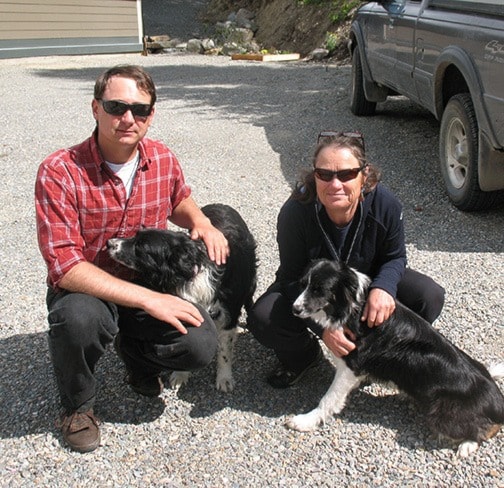While most people in Marysville were still in bed, or enjoying their morning coffee, two border collies — Bob and Tess — were moving deer. There was no fuss, no muss, no stampede — just a group of deer moving out of town under the guidance of two very well trained dogs.
Kimberley’s one-time only trial with aversive conditioning of urban deer took place on Wednesday morning, May 29, 2013.
It was kept purposely low-key, with only a few deer committee members, the provincial government biologist Irene Teske, and Coun. Darryl Oakley along to watch as John Zehnder and Margie Jamieson let their dogs do their thing.
“It went well,” Zehnder said. “We did a group of deer at Bootleg Gap and then up towards the transfer station. I think the people watching learned a lot and got a good understanding of how it works.”
This was a trial only, allowed under special permission from the Ministry of Forests, Lands and Natural Resources.
The deer removed today will return to town. A full aversive conditioning program will require repetition of today’s events until the deer understand they will not be bothered out of town.
“We condition the deer to know that town is not a good place to be,” Jamieson said. “Out of town is the safe zone and the pressure is off.”
“The deer see the town as a shelter from predators and as a food source,” Zehnder. “They feel comfortable here.”
“In a sense what you do with the dogs is introduce a predator to their safety zone,” Jamieson said.
Both stress that this is a non-traumatic way to move deer.
“The deer move from the dogs, but they are allowed the freedom to move in the right direction,” Jamieson said.
“We are taking advantage of a natural instinct,” Zehnder said.
“These deer saw the dogs, their ears went up and they were ready to move.”
The dogs are off leash, but Zehnder says they are on a ‘verbal leash’.
“They have total recall. You can call them off at any point. They will stop on a dime.”
“We can direct their movement right or left,” Jamieson said. “What was evident today was not control over the deer but control over the direction the deer go. It works like a funnel with the dogs working the flanks, keeping the deer directed. For the deer, the right direction is the easiest option.”
“We want them to feel as if they are being hunted,” Zehnder said. “That’s why the dogs are off lease. We can put as much pressure on them as required by the situation.”
Both Zehnder and Jamieson have previous experience with hazing, or aversive conditioning. They have worked in national park areas such as Banff and Waterton. They acknowledge that what is being done in Kimberley is the first of its kind.
“It’s never been done outside of a national park before,” Jamieson said.
“It’s never been done in a municipality,” Zehnder said. “This is a first. It’s a pretty significant trial.”
However, both say aversive conditioning, no matter how successful, will only work in certain parts of town, and must be part of a multi-pronged approach to problems with urban deer.
“We’ve seen it work, but it’s one prong,” Jamieson said. “There is also education, fencing, non-feeding.”
“And there is culling,” Zehnder said. “I like to promote a more selective cull.”
Jamieson agrees. “Instead of a massive cull, you target the problem deer. If you kill 100 deer and don’t get the four aggressive ones, you haven’t solved your problem.”
Both say that for a trial run, Marsyville is an ideal set up with crown land on the edges rather than acreages and farms.
“We really do want to acknowledge Gary Glinz and Sherry Shrieves from the Deer Committee and Darryl Oakley. They really worked hard for this. They didn’t just get permission for a trial, they are looking to change legislation.”
“It’s very progressive thinking,” Zehnder said.
